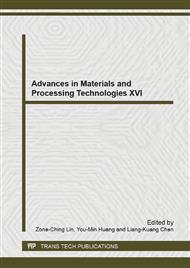p.400
p.409
p.415
p.422
p.430
p.437
p.445
p.451
p.459
Thermomechanical Forming of NiTi Shape Memory Alloy Wire
Abstract:
Because of their smart characteristics with shape memory effect and superelasticity, NiTi shape memory alloys used in sensors and actuators are regarded as an emerging applied material with high added value by their additional biomedical compatibility for medical devices and implants. It is meaningful to pay more attention to study the production technique of NiTi shape memory alloys. For this reason, this article is aimed to investigate the results of a NiTi shape memory alloy wire in thermomechanical forming process regarding the processing temperature and duration. Thereafter a NiTi shape memory alloy wire of 0.63 mm in diameter is formed in a furnace at 450°C, 500°C, 550°C, and 600°C, respectively, by a semi cylindrical punch of 32 mm in diameter, then held together with the die set in the furnace for 10, 30, and 50 minutes long, respectively, and then quenched in the water. All of the formed wires have shape memory effect. That is, the wires returned their formed geometry once they were straightened below martensite transformation finishing temperature about room temperature and heated again above austenite transformation finishing temperature about 70°C. These thermomechanical forming processes were also investigated by commercial finite element software DEFORM. Both analytical and experimental results showed that the formed wires could not have the geometry precision as wanted because of stress relaxation found in process, which depends on the process temperature and the treatment duration. As a result, the lower the temperature and the shorter the duration is, the larger the springback is. That means that the higher the treatment temperature is and the longer the holding time is, the better the precision of the formed part is.
Info:
Periodical:
Pages:
430-436
Citation:
Online since:
May 2014
Authors:
Price:
Сopyright:
© 2014 Trans Tech Publications Ltd. All Rights Reserved
Share:
Citation:


